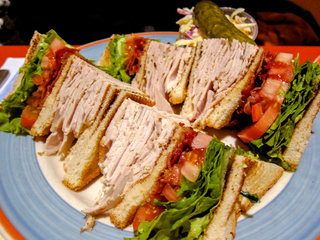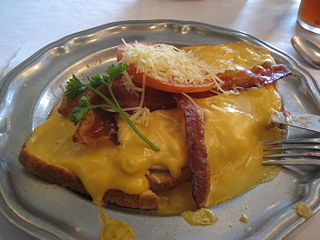
A club sandwich, also called a clubhouse sandwich, is a sandwich consisting of bread, sliced cooked poultry, fried bacon, lettuce, tomato, and mayonnaise. It is often cut into quarters or halves and held together by cocktail sticks. Modern versions frequently have two layers which are separated by an additional slice of bread.

An open sandwich, also known as an open-face/open-faced sandwich, bread baser, bread platter or tartine, consists of a slice of bread or toast with one or more food items on top. It has half the number of slices of bread compared to a typical closed sandwich.

The grilled cheese is a hot cheese sandwich typically prepared by heating slices of cheese between slices of bread with a cooking fat such as butter or mayonnaise on a frying pan, griddle, or sandwich toaster, until the bread browns and the cheese melts.

A bacon sandwich is a sandwich of cooked bacon between bread that is optionally spread with butter, and may be seasoned with ketchup or brown sauce. It is generally served hot. In some establishments the sandwich will be made from bread toasted on only one side, while other establishments serve it on the same roll as is used for hamburgers.

A Hot Brown sandwich is an American hot sandwich originally created at the Brown Hotel in Louisville, Kentucky, by Fred K. Schmidt in 1926. It is a variation of traditional Welsh rarebit and was one of two signature sandwiches created by chefs at the Brown Hotel shortly after its founding in 1923. It was created to serve as an alternative to ham and egg late-night dinners.

A tuna fish sandwich, known outside the United States as a tuna salad sandwich or a tuna sandwich, is a sandwich made from canned tuna—usually made into a tuna salad by adding mayonnaise, and sometimes other ingredients such as celery or onion—as well as other common fruits and vegetables used to flavour sandwiches. It is commonly served on sliced bread.

The McDonald's Premium line is a group of products introduced by McDonald's in the spring of 2003. It includes the company's larger chicken sandwiches, its salad line, and its coffee products. The sandwiches are targeted at various demographic markets, the grilled chicken sandwiches and salads are targeted at both the female and health-conscious demographic markets. The entire line is intended to bring in a larger, more affluent, adult audience seeking better quality products.

The ham sandwich is a common type of sandwich. The bread may be fresh or toasted, and it can be made with a variety of toppings including cheese and vegetables like lettuce, tomato, onion or pickle slices. Various kinds of mustard and mayonnaise are also common.
Baconnaise is a bacon-flavored, mayonnaise-based food spread that is ovo vegetarian and kosher certified. It was created by Justin Esch and Dave Lefkow, founders of J&D's Foods, in November 2008, and sold 40,000 jars within six months. It was test-marketed in Grand Forks, North Dakota, to determine consumer interest. After being featured on both The Daily Show and The Oprah Winfrey Show, sales of Baconnaise increased significantly, with more than a million jars sold.

A lettuce sandwich is a wrap with lettuce substituted for the bread, or a sandwich with a filling consisting primarily of lettuce. It should not be confused with other sandwiches that use lettuce as one of many ingredients, such as the BLT sandwich or the tomato and lettuce sandwich. The lettuce sandwich has a long history in both the United States and the United Kingdom. It has been used as a metaphor to represent things like mundanity, weakness and poverty. In more recent times, the lettuce sandwich, including lettuce hamburgers have symbolized diets including the keto diet.

The bocadillo or bocata, in Spain, is a sandwich made with Spanish bread, usually a baguette or similar type of bread, cut lengthwise. Traditionally seen as a humble food, its low cost has allowed it to evolve over time into an iconic piece of cuisine. In Spain, they are often eaten in cafes and tapas bars.

The cheese dream is an open-faced version of the American grilled cheese sandwich made with bread and cheese; it is cooked with either oil, margarine, or butter. Other ingredients such as bacon, avocado, pineapple, eggs, or sliced tomato can be optionally added to the open-faced sandwich as well.

The BLT Cookbook is a cookbook about the preparation of bacon, lettuce, and tomato (BLT) sandwiches. It was written by Michele Anna Jordan and was published by William Morrow Cookbooks in the United States in June 2003. Jordan is a food writer and has written for The Press Democrat; The BLT Cookbook is her 14th published book. She researched the book for ten years and in the process she taste-tested hundreds of variations on the sandwich, describing it as America's most beloved sandwich. She instructs the reader on how to acquire and prepare the best ingredients for the sandwich. The book includes recipes with varying ingredients, though each recipe includes tomatoes. Many recipes in the book are not sandwiches, and include appetizers, soups, salads, and desserts. Jordan also suggests wines to accompany the sandwich.

I Love Bacon! is a cookbook with over fifty recipes devoted to bacon and bacon dishes, many of them from celebrity chefs. The book was written by Jayne Rockmill and photography was provided by Ben Fink. Broken down into eight sections, the book covered how to make homemade bacon and moves onto "brunch" and "small bites" before covering soups, salads and sides, pasta, fish, meat, and desserts. I Love Bacon! was published in October 2010 by Andrews McMeel Publishing and met with favorable reviews for its unique dishes and helpful culinary tips for novices.

The Big N’ Tasty is a hamburger sold by the international fast food chain McDonald's. It is designed to compete with the Whopper sandwich. A similar variation called the Big Tasty, without the center "N'", which was first released in Saudi Arabia, is sold outside the United States in parts of Europe, South America, South Africa, The Middle East, and Taiwan.

A toast sandwich is a sandwich in which the filling between two slices of bread is itself a thin slice of toasted bread, which may be buttered. An 1861 recipe says to add salt and pepper to taste.

A Pilgrim or Puritan is a sandwich which has connotations with the American Pilgrim Fathers and Thanksgiving Day. It was a traditional way of using up leftover food from Thanksgiving Day and thus is composed essentially of bread slices or a roll, into which are placed sliced roast turkey, stuffing, mashed potatoes, cranberries or cranberry sauce, gravy, and/or other toppings such as cheese, lettuce or mayonnaise. There is an enormous variation in its composition with a huge range of ingredients being employed in some sandwiches and a great variation of ingredients between recipes. A basic combination might include slices of turkey, herb stuffing, cranberry sauce and some gravy between two slices of bread.

Lettuce soup is a soup prepared with lettuce as a primary ingredient. It may be prepared with additional ingredients, and some lettuce soups may use several cultivars of lettuce in their preparation. It is a part of French cuisine and Chinese cuisine. Cream of lettuce soup is a type of lettuce soup prepared using milk or cream. The soup may be served with toast or rolls as a side dish or with the soup atop them. It may be served as an appetizer, a side dish or as a main dish, and may be served hot or cold.

Pastrami on rye is a sandwich comprising sliced pastrami on rye bread, often served with mustard and Kosher dill pickles. It was popularized in the Jewish delicatessens of New York City and has been described as New York's "signature sandwich". It was created in 1888 by the Lithuanian immigrant Sussman Volk, who served it at his deli on Delancey Street in Manhattan.





















